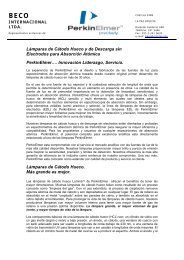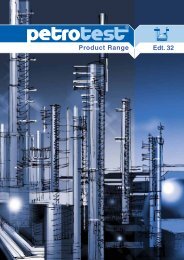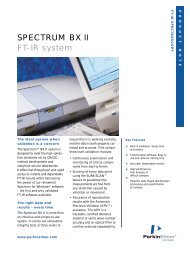General Catalogue Chemistry - BECO Internacional LTDA.
General Catalogue Chemistry - BECO Internacional LTDA.
General Catalogue Chemistry - BECO Internacional LTDA.
You also want an ePaper? Increase the reach of your titles
YUMPU automatically turns print PDFs into web optimized ePapers that Google loves.
analysis methods<br />
Viscosity<br />
64 LEYBOLD DIDACTIC · GENERAL CATALOGUE CHEMISTRY<br />
665 906<br />
Falling ball viscometer after Höppler<br />
Substances differ one from the other not only<br />
according to their viscosity, but also because of<br />
differences in their structures and flow properties.<br />
The widespread view that the viscosity is<br />
a value typical for a particular substance, independent<br />
of shear load is only true for “Newtonian”<br />
fluids. The greater majority of all materials,<br />
however, demonstrates “non-Newtonian” flow<br />
properties, characterized by the dependency of<br />
the viscosity on shear load and shear duration.<br />
Among these “flow anomalies” are the structural<br />
viscosity, dilatancy, plasticity, thixotropy and<br />
rheopexy. The flow curve - the graphic representation<br />
of the relationship between shear rate and<br />
shearing strain -describes the flow properties in a<br />
clear and complete manner.<br />
Precise measurements on transparent “Newtonian”<br />
liquids can be made using a falling ball viscometer.<br />
The falling ball viscometer is used for precise measurement of the viscosity<br />
of transparent “Newtonian” liquids and gases. It complies with the requirements<br />
set forth in DIN standard 530 15 and has been approved by the German<br />
Physical Technical Bureau for official calibration purposes.<br />
Measurement principle<br />
Rolling, sliding movement of a ball in an inclined, cylindrical tube filled with<br />
the fluid which is to be examined. The time is taken which the ball requires<br />
to travel a defined measurement distance. The test cylinder can be turned<br />
upside down for additional measurement of the return of the ball.<br />
The measurement results are given as dynamic viscosity in the internationally<br />
standardized absolute unit of measure, millipascal-second [mPa · s]<br />
Temperature control<br />
Since viscosity is highly dependent on temperature, provision has been<br />
made for exact control of the sample temperature. This can be done, for<br />
example, with the recirculation thermostat (> 666 7701) or the recirculation<br />
cooler (> 666 766). The temperature is monitored using a thermometer<br />
which has been built into the viscometer (standard -1 °C to 26 °C, 0.1 K<br />
graduations).<br />
Typical application examples<br />
The falling ball viscometer is used primarily for low-viscosity substances,<br />
such as): oils, liquid hydrocarbons (petroleum industry), solvents, solutions of<br />
plastics and resins as well as inks (chemical industry), glycerine, raw materials<br />
(pharmaceutical industry), gelatines, sugar solutions (food industry).<br />
Viscosity range: 0,5 ... 10 5 mPa · s (cP)<br />
Temperature range: -20 ... +120 °C<br />
Repeatability: better than 0.5 %<br />
Comparability: better than 1 %<br />
Material: cylinder and balls 1, 2 and G are made of borosilicate glass;<br />
balls 3 and 4 are made of nickel/iron, balls 5 and 6 are made of steel<br />
Dimensions: 335 x 200 x 265 mm<br />
Weight: 5.7 kg






